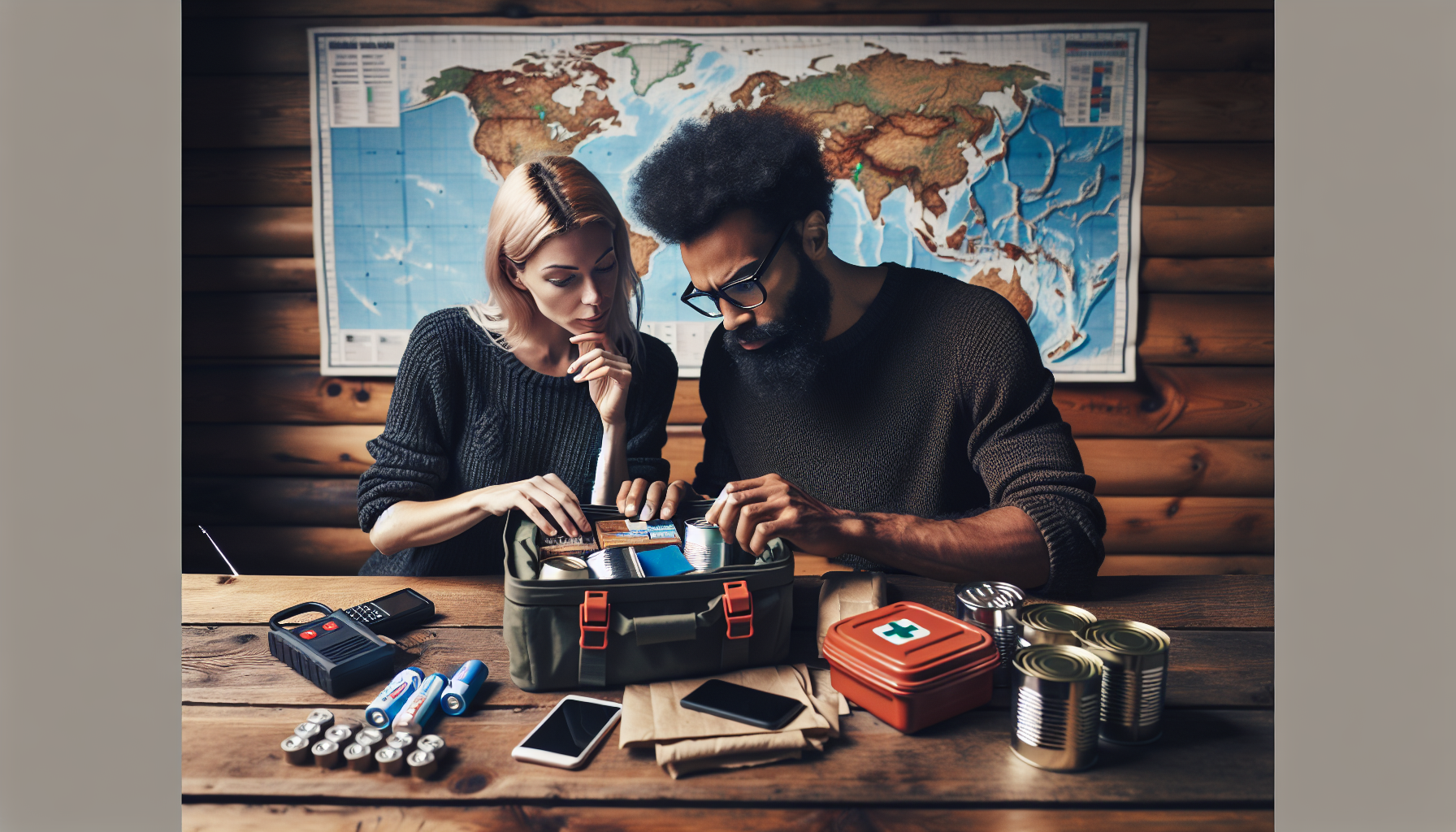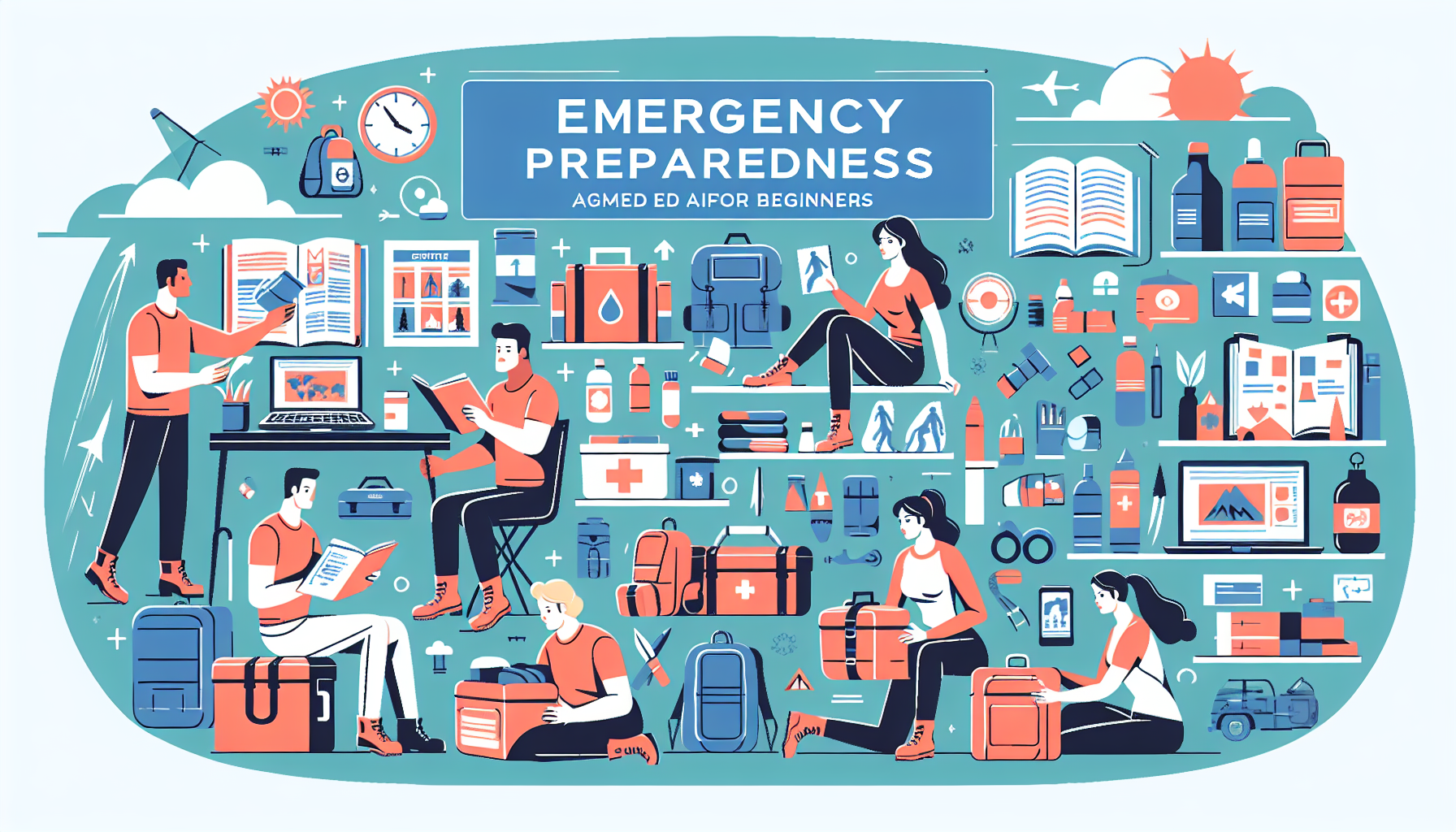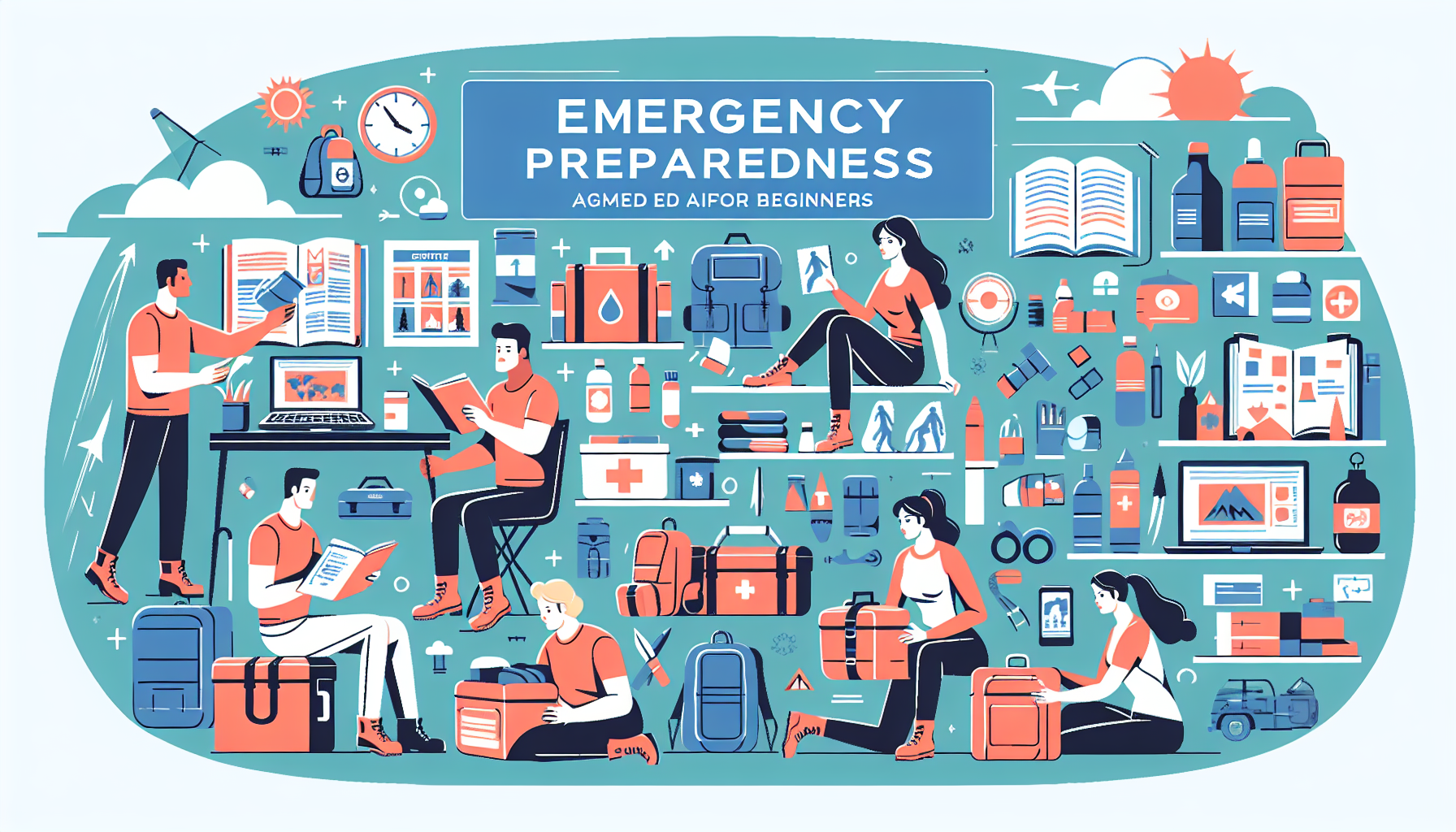So you’ve decided that it’s time to start preparing for various emergencies and disasters, but you’re not quite sure where to begin. Don’t worry, you’re not alone! Many people find themselves overwhelmed when it comes to prepping. In this article, we’ll provide you with some helpful tips and guidance on how to start your prepping journey. Whether you’re new to this concept or looking to refine your skills, we’ve got you covered. Let’s dive right in and explore the essential steps that will set you on the path of becoming a prepared and resilient individual.
Research and Education
Learn about the Concept of Preparedness
Before diving into the world of prepping, it’s essential to understand the concept of preparedness. Preparedness refers to the proactive measures individuals take to ensure they are ready to face and handle emergencies or unexpected situations effectively. By investing time in educating yourself about preparedness, you can develop a solid foundation of knowledge that will guide you throughout your prepping journey.
Understand Potential Risks and Hazards
When it comes to prepping, one of the first steps is to identify and understand the potential risks and hazards that could affect your area. Conduct thorough research to determine the specific natural disasters or other emergencies that are most likely to occur in your region. This could include earthquakes, hurricanes, wildfires, floods, or even man-made disasters like power outages or civil unrest. By understanding these potential risks, you can tailor your preparedness efforts to address them adequately.
Study Survival Skills and Techniques
Building your competence in survival skills and techniques is crucial in preparing for emergencies. Start by learning basic first aid and CPR, as these skills can make a significant difference in saving lives during critical situations. Additionally, consider acquiring outdoor survival skills such as navigating without a compass, starting a fire, purifying water, and building a temporary shelter. With each skill you acquire, you’ll gain more confidence and be better prepared to handle unexpected challenges.
Establish a Plan
Assess Your Needs and Priorities
When developing a preparedness plan, it’s essential to assess your specific needs and priorities. Take into account your living situation, the number of family members or dependents, any medical conditions that require special attention, and any unique circumstances that may affect your preparedness efforts. By understanding your needs, you can tailor your plan to ensure that all crucial aspects are addressed effectively.
Determine Your Resources and Budget
Another crucial step in establishing a preparedness plan is to determine the resources available to you, both in terms of physical supplies and financial capabilities. Take stock of the resources you already have, such as emergency supplies, tools, and equipment. Assess your budget and allocate funds specifically for prepping endeavors. This will help you prioritize your expenditure and ensure that you are making informed decisions about the resources you acquire.
Develop a Comprehensive Preparedness Plan
Once you’ve assessed your needs and resources, it’s time to develop a comprehensive preparedness plan. Your plan should include specific details on various aspects, such as emergency supplies, communication strategies, shelter options, financial preparations, health and wellness considerations, survival skills training, and community involvement. Creating a detailed plan will serve as a roadmap to guide your actions during emergencies, ensuring that you are well-prepared to handle any situation that may arise.

Emergency Supplies
Create a Basic Emergency Kit
One of the essential aspects of prepping is creating a basic emergency kit. This kit should contain essential items that will sustain you and your family during the initial stages of an emergency. Items to include in your emergency kit are non-perishable food items, drinking water, a flashlight, extra batteries, a first aid kit, hygiene products, a multipurpose tool, a battery-powered or hand-crank radio, a whistle, and important documents and cash. Ensure that you periodically check and update your emergency kit to ensure everything is in working order and to replenish any expired items.
Stockpile Food and Water
In addition to your emergency kit, it’s crucial to stockpile an adequate supply of food and water. Aim to have at least a three-day supply of non-perishable food items that do not require cooking or refrigeration. Choose foods that are nutritionally dense and have a long shelf life. Additionally, store at least one gallon of water per person per day for drinking and basic hygiene needs. Consider investing in water purification methods to ensure a long-term supply of safe drinking water.
Gather Essential Medications and First Aid Supplies
If you or any family members rely on medications, it’s essential to have an ample supply of these medications in your emergency preparedness supplies. Consult with your healthcare provider to understand which medications should be included in your emergency stash and the appropriate way to store them. Additionally, ensure that you have a comprehensive first aid kit that includes items necessary for treating minor injuries and managing medical emergencies until professional help is available.
Emergency Communication
Establish Communication Channels
During emergencies, communication is of utmost importance. Establishing reliable communication channels before disaster strikes can ensure that you can connect with your loved ones and gather important information. Invest in a battery-powered or hand-crank radio to stay updated with emergency broadcasts. Consider having multiple methods of communication, such as a cell phone, walkie-talkies, or satellite phones, in case one method fails.
Prepare a List of Emergency Contacts
Create a list of emergency contacts that includes local authorities, emergency services, and important phone numbers of family members, friends, and neighbors. Make sure each family member carries a copy of this list in their emergency kit or wallet. Designate a meeting point or a contact person who can serve as a central hub for gathering information and relaying messages in case of communication disruption.
Consider Alternative Communication Methods
In situations where traditional communication methods may not be available, it’s essential to consider alternative communication methods. These may include signaling techniques such as whistles, flares, or visual signals, as well as learning basic Morse code. Additionally, familiarize yourself with local emergency radio frequencies and designated communication channels used by emergency responders.

Secure Shelter
Identify Safe Locations and Emergency Exits
Knowing the safe locations and emergency exits in your home and workplace is essential for ensuring your safety during emergencies. Familiarize yourself with the layout of your home or workplace and identify areas that offer the most protection during different types of emergencies, such as earthquakes or severe storms. Locate all emergency exits, and ensure they are clear of obstacles and easy to access.
Strengthen and Secure Your Home
Taking proactive measures to strengthen and secure your home can greatly enhance its resilience during emergencies. Conduct a thorough assessment of your home’s structural weaknesses and address them accordingly. This may involve reinforcing windows and doors, securing heavy furniture and appliances, and ensuring your home’s foundation is stable. Additionally, consider installing smoke detectors, carbon monoxide detectors, and fire extinguishers throughout your home.
Prepare an Emergency Shelter
In some cases, emergencies may require you to seek temporary shelter outside your home. Prepare for this possibility by identifying community emergency shelters in your area and understanding their protocols. Additionally, consider purchasing or assembling a portable emergency shelter, such as a tent or a tarp, that can provide protection and comfort during outdoor situations. Include this shelter in your emergency supplies so that it’s readily available when needed.
Financial Preparations
Build an Emergency Fund
Establishing an emergency fund is a crucial aspect of financial preparedness. Saving money specifically for emergencies can help you address unexpected expenses that may arise during or after a disaster. Aim to gradually build an emergency fund that covers at least three to six months’ worth of living expenses. Consider automating regular contributions to your emergency fund to ensure consistent savings.
Evaluate Insurance Coverage
Reviewing and updating your insurance coverage is vital to ensure you are adequately protected in case of emergencies. Assess your homeowner’s or renter’s insurance policy to understand the extent of coverage it provides for various types of disasters. Consider adding additional coverage if necessary, such as flood insurance or earthquake insurance, depending on the risks prevalent in your area. Additionally, review your health insurance policy to ensure it covers medical emergencies and necessary treatments.
Make Financial Plans for Disaster-related Expenses
Beyond insurance coverage, it’s essential to make financial plans for disaster-related expenses. These may include costs associated with evacuation, temporary housing, property repairs or replacements, and medical expenses. Set aside a dedicated portion of your emergency fund specifically for these expenses. Explore disaster relief programs and resources available in your area that can provide financial assistance during emergencies.
Health and Wellness
Ensure Regular Medical Check-ups
Maintaining good health is critical for ensuring your overall preparedness. Schedule regular medical check-ups to monitor your health and address any underlying medical conditions. Discuss your prepping efforts with your healthcare provider to obtain any necessary medical advice or prescriptions. Additionally, ensure that all family members are up to date with their vaccinations and have necessary medical records stored in a safe and easily accessible location.
Maintain a Healthy Lifestyle
Adopting a healthy lifestyle can significantly improve your resilience during emergencies. Focus on maintaining a balanced diet, engaging in regular exercise, and getting sufficient sleep. Prioritize stress-management techniques such as meditation or yoga to build mental and emotional resilience. Avoid harmful habits such as excessive alcohol consumption or smoking, as they can compromise your physical and mental well-being.
Create and Follow a Wellness Plan
Developing a wellness plan ensures that you prioritize your health and well-being during emergencies. This plan should incorporate aspects such as maintaining a healthy diet and exercise routine, managing stress effectively, and addressing any specific health concerns you or your family members may have. Regularly review and update your wellness plan to ensure it remains aligned with your evolving needs and circumstances.
Develop Survival Skills
Learn Basic First Aid and CPR
Acquiring basic first aid and CPR skills is invaluable in emergency situations. Enroll in a certified first aid and CPR course to learn how to respond effectively to medical emergencies, injuries, and life-threatening situations. These skills can provide critical assistance to yourself, your family members, or even strangers during times of crisis.
Improve Self-defense Techniques
In addition to medical skills, it’s essential to develop self-defense techniques to protect yourself and your loved ones from potential threats. Consider taking self-defense classes that focus on practical and effective techniques for personal safety. Learn to assess and react to potentially dangerous situations, understand situational awareness, and practice self-defense maneuvers that can provide a layer of security in times of need.
Acquire Outdoor Survival Skills
Enhancing your outdoor survival skills can greatly increase your self-reliance during emergencies or situations where you may find yourself in unfamiliar surroundings. Learn how to navigate using a compass or landmarks, start a fire using various methods, purify water from natural sources, and create temporary shelters from readily available materials. These skills will equip you with the confidence and knowledge needed to survive in outdoor environments.
Community Involvement
Join Local Preparedness Groups
Getting involved in local preparedness groups and organizations can offer valuable support and resources during emergencies. Connect with like-minded individuals who share your interest in prepping and join local community-based preparedness groups. These groups often organize training sessions, workshops, and emergency drills that can further enhance your preparedness knowledge and skills. In addition, being part of a community of preppers provides opportunities for information sharing, networking, and collaborative efforts.
Participate in Emergency Drills
Emergency drills are essential for testing your preparedness plan and ensuring that everyone in your household knows what to do in different emergency scenarios. Participate in local or community-organized emergency drills whenever possible. These drills simulate real-life scenarios and allow you to practice implementing your preparedness plan. By actively participating in drills, you can identify any gaps or areas for improvement in your plan and make necessary adjustments.
Contribute to Community Resilience
Contributing to community resilience involves taking an active role in enhancing the preparedness of your local community. Share your knowledge and expertise with others through volunteering or organizing educational events. Encourage your neighbors, friends, and family members to prioritize preparedness efforts and create a sense of shared responsibility in your community. By working together, you can build a resilient community capable of effectively responding to and recovering from emergencies.
Stay Informed
Follow Trusted News Sources
In times of emergencies, staying informed is essential. However, it’s equally important to ensure that the information you receive is accurate and reliable. Identify trusted news sources, such as local government agencies, reputable media outlets, and official emergency management channels. Regularly check these sources for updates on potential risks, hazards, and emergency situations. Avoid spreading or relying on unverified information that could lead to panic or misinformation.
Monitor Weather and Disaster Alerts
Understanding the weather conditions and disaster alerts specific to your area is crucial for timely preparedness actions. Stay informed about local weather patterns, forecasts, and any severe weather warnings issued by meteorological agencies. Sign up for emergency alerts through platforms operated by local authorities or national emergency management agencies. These alerts will notify you of potential hazards and provide instructions on necessary precautions or evacuation procedures.
Stay Up-to-date with Government Guidelines
Government guidelines and directives play a crucial role during emergencies. Stay up-to-date with the guidelines and recommendations issued by local, regional, and national authorities. These guidelines may include evacuation routes, emergency protocols, or specific instructions for different types of emergencies. By following these guidelines, you can ensure that your preparedness actions align with the overall emergency response efforts in your area.
In conclusion, starting your prepping journey requires a comprehensive and well-thought-out approach. By conducting thorough research, establishing a plan, gathering emergency supplies, prioritizing communication, securing shelter, making financial preparations, focusing on health and wellness, developing survival skills, engaging in the community, staying informed, and continuously learning, you can confidently navigate through any emergency or unexpected situation that comes your way. Remember, being prepared is not just about individual readiness but also about contributing to a resilient and prepared community.
